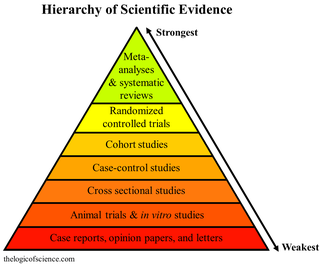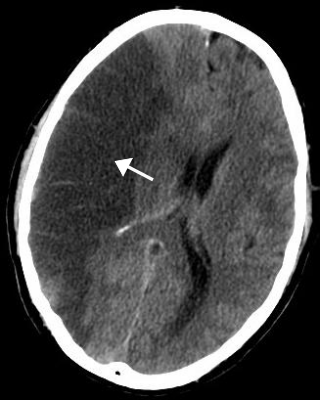Related Research Articles
Evidence-based medicine (EBM) is "the conscientious, explicit and judicious use of current best evidence in making decisions about the care of individual patients." The aim of EBM is to integrate the experience of the clinician, the values of the patient, and the best available scientific information to guide decision-making about clinical management. The term was originally used to describe an approach to teaching the practice of medicine and improving decisions by individual physicians about individual patients.

Malaria is a mosquito-borne infectious disease that affects humans and other vertebrates. Human malaria causes symptoms that typically include fever, fatigue, vomiting, and headaches. In severe cases, it can cause jaundice, seizures, coma, or death. Symptoms usually begin 10 to 15 days after being bitten by an infected Anopheles mosquito. If not properly treated, people may have recurrences of the disease months later. In those who have recently survived an infection, reinfection usually causes milder symptoms. This partial resistance disappears over months to years if the person has no continuing exposure to malaria.

A meta-analysis is a statistical analysis that combines the results of multiple scientific studies. Meta-analyses can be performed when there are multiple scientific studies addressing the same question, with each individual study reporting measurements that are expected to have some degree of error. The aim then is to use approaches from statistics to derive a pooled estimate closest to the unknown common truth based on how this error is perceived. It is thus a basic methodology of metascience. Meta-analytic results are considered the most trustworthy source of evidence by the evidence-based medicine literature.

Otitis media is a group of inflammatory diseases of the middle ear. One of the two main types is acute otitis media (AOM), an infection of rapid onset that usually presents with ear pain. In young children this may result in pulling at the ear, increased crying, and poor sleep. Decreased eating and a fever may also be present. The other main type is otitis media with effusion (OME), typically not associated with symptoms, although occasionally a feeling of fullness is described; it is defined as the presence of non-infectious fluid in the middle ear which may persist for weeks or months often after an episode of acute otitis media. Chronic suppurative otitis media (CSOM) is middle ear inflammation that results in a perforated tympanic membrane with discharge from the ear for more than six weeks. It may be a complication of acute otitis media. Pain is rarely present. All three types of otitis media may be associated with hearing loss. If children with hearing loss due to OME do not learn sign language, it may affect their ability to learn.

The Cochrane Collaboration is a British international charitable organisation formed to synthesise medical research findings to facilitate evidence-based choices about health interventions involving health professionals, patients and policy makers. It includes 53 review groups that are based at research institutions worldwide. Cochrane has approximately 30,000 volunteer experts from around the world.

The Cochrane Library is a collection of databases in medicine and other healthcare specialties provided by Cochrane and other organizations. At its core is the collection of Cochrane Reviews, a database of systematic reviews and meta-analyses which summarize and interpret the results of medical research. The Cochrane Library aims to make the results of well-conducted controlled trials readily available and is a key resource in evidence-based medicine.

Smoking cessation, usually called quitting smoking or stopping smoking, is the process of discontinuing tobacco smoking. Tobacco smoke contains nicotine, which is addictive and can cause dependence. As a result, nicotine withdrawal often makes the process of quitting difficult.

Peripheral neuropathy, often shortened to neuropathy, is a general term describing damage or disease affecting the nerves. Damage to nerves may impair sensation, movement, gland function, and/or organ function depending on which nerves are affected. Neuropathy affecting motor, sensory, or autonomic nerves result in different symptoms. More than one type of nerve may be affected simultaneously. Peripheral neuropathy may be acute or chronic, and may be reversible or permanent.

An upper respiratory tract infection (URTI) is an illness caused by an acute infection, which involves the upper respiratory tract, including the nose, sinuses, pharynx, larynx or trachea. This commonly includes nasal obstruction, sore throat, tonsillitis, pharyngitis, laryngitis, sinusitis, otitis media, and the common cold. Most infections are viral in nature, and in other instances, the cause is bacterial. URTIs can also be fungal or helminthic in origin, but these are less common.

Low back pain (LBP) or lumbago is a common disorder involving the muscles, nerves, and bones of the back, in between the lower edge of the ribs and the lower fold of the buttocks. Pain can vary from a dull constant ache to a sudden sharp feeling. Low back pain may be classified by duration as acute, sub-chronic, or chronic. The condition may be further classified by the underlying cause as either mechanical, non-mechanical, or referred pain. The symptoms of low back pain usually improve within a few weeks from the time they start, with 40–90% of people recovered by six weeks.

Stroke is a medical condition in which poor blood flow to the brain causes cell death. There are two main types of stroke: ischemic, due to lack of blood flow, and hemorrhagic, due to bleeding. Both cause parts of the brain to stop functioning properly.

A systematic review is a scholarly synthesis of the evidence on a clearly presented topic using critical methods to identify, define and assess research on the topic. A systematic review extracts and interprets data from published studies on the topic, then analyzes, describes, critically appraises and summarizes interpretations into a refined evidence-based conclusion. For example, a systematic review of randomized controlled trials is a way of summarizing and implementing evidence-based medicine.

Sir Iain Geoffrey Chalmers is a British health services researcher, one of the founders of the Cochrane Collaboration, and coordinator of the James Lind Initiative, which includes the James Lind Library and James Lind Alliance.

Postpartum bleeding or postpartum hemorrhage (PPH) is often defined as the loss of more than 500 ml or 1,000 ml of blood following childbirth. Some have added the requirement that there also be signs or symptoms of low blood volume for the condition to exist. Signs and symptoms may initially include: an increased heart rate, feeling faint upon standing, and an increased breathing rate. As more blood is lost, the patient may feel cold, blood pressure may drop, and they may become restless or unconscious. The condition can occur up to six weeks following delivery.

A salt substitute, also known as low-sodium salt, is a low-sodium alternative to edible salt marketed to reduce the risk of high blood pressure and cardiovascular disease associated with a high intake of sodium chloride while maintaining a similar taste.
Embase is a biomedical and pharmacological bibliographic database of published literature designed to support information managers and pharmacovigilance in complying with the regulatory requirements of a licensed drug. Embase, produced by Elsevier, contains over 32 million records from over 8,500 currently published journals from 1947 to the present. Through its international coverage, daily updates, and drug indexing with EMTREE, Embase enables tracking and retrieval of drug information in the published literature. Each record is fully indexed and Articles in Press are available for some records and In Process are available for all records, ahead of full indexing. Embase's international coverage expands across biomedical journals from 95 countries and is available through a number of database vendors.

Neck pain, also known as cervicalgia, is a common problem, with two-thirds of the population having neck pain at some point in their lives.
The discipline of evidence-based toxicology (EBT) strives to transparently, consistently, and objectively assess available scientific evidence in order to answer questions in toxicology, the study of the adverse effects of chemical, physical, or biological agents on living organisms and the environment, including the prevention and amelioration of such effects. EBT has the potential to address concerns in the toxicological community about the limitations of current approaches to assessing the state of the science. These include concerns related to transparency in decision making, synthesis of different types of evidence, and the assessment of bias and credibility. Evidence-based toxicology has its roots in the larger movement towards evidence-based practices.
Lesley Ann Stewart is a Scottish academic whose research interests are in the development and application of evidence synthesis methods, particularly systematic reviews and individual participant data meta-analysis. She is head of department for the Centre for Reviews and Dissemination at the University of York and director for the NIHR Evidence Synthesis Programme. She was one of the founders of the Cochrane Collaboration in 1993. Stewart served as president of the Society for Research Synthesis Methodology (2013-2016) and was a founding co-editor in chief of the academic journal Systematic Reviews (2010–2021).
The International Prospective Register of Systematic Reviews, better known as PROSPERO, is an open access online database of systematic review protocols on a wide range of topics. While it was initially restricted to medicine, as of 2021, it also accepts protocols in criminology, social care, education and international development, as long as there is a health-related outcome. Researchers can choose to have their reviews prospectively registered with PROSPERO. The database is produced by the Centre for Reviews and Dissemination at the University of York in England, and it is funded by the National Institute for Health Research. Registration of systematic reviews in the database has been supported by PLoS Medicine, BioMed Central, the EQUATOR Network, and BMJ editor-in-chief Fiona Godlee, among others.
References
- ↑ Garritty, Chantelle; Gartlehner, Gerald; Nussbaumer-Streit, Barbara; King, Valerie J.; Hamel, Candyce; Kamel, Chris; Affengruber, Lisa; Stevens, Adrienne (February 2021). "Cochrane Rapid Reviews Methods Group offers evidence-informed guidance to conduct rapid reviews". Journal of Clinical Epidemiology. 130: 13–22. doi:10.1016/j.jclinepi.2020.10.007. PMC 7557165 . PMID 33068715.
- 1 2 "Cochrane Covid Rapid Reviews". Cochrane Covid Rapid Reviews. The Cochrane Collaboration. Retrieved December 17, 2020.
- ↑ Khangura, Sara; Konnyu, Kristin; Cushman, Rob; Grimshaw, Jeremy; Moher, David (2012-02-10). "Evidence summaries: the evolution of a rapid review approach". Systematic Reviews. 1 (1): 10. doi: 10.1186/2046-4053-1-10 . ISSN 2046-4053. PMC 3351736 . PMID 22587960.
- ↑ Tricco, Andrea C.; Langlois, Etienne V.; Straus, Sharon E. (2017). Rapid reviews to strengthen health policy and systems: a practical guide. World Health Organization. hdl:10665/258698. ISBN 978-92-4-151276-3.
- ↑ Brooks, Samantha K.; Webster, Rebecca K.; Smith, Louise E.; Woodland, Lisa; Wessely, Simon; Greenberg, Neil; Rubin, Gideon James (2020-03-14). "The psychological impact of quarantine and how to reduce it: rapid review of the evidence". The Lancet. 395 (10227): 912–920. doi:10.1016/S0140-6736(20)30460-8. ISSN 0140-6736. PMC 7158942 . PMID 32112714.
- 1 2 3 Rico, Sergio; Ali, Nauman Bin; Engström, Emelie; Host, Martin (16 December 2020). "Guidelines for conducting interactive rapid reviews in software engineering -- from a focus on technology transfer to knowledge exchange". doi:10.5281/zenodo.4327725. S2CID 234929855.
{{cite journal}}: Cite journal requires|journal=(help) - ↑ Song, Qunying; Borg, Markus; Engström, Emelie; Ardö, Håkan; Rico, Sergio (17 October 2022). "Exploring ML testing in practice: Lessons learned from an interactive rapid review with axis communications". Proceedings of the 1st International Conference on AI Engineering: Software Engineering for AI. pp. 10–21. doi:10.1145/3522664.3528596. ISBN 9781450392754. S2CID 247793031.
- ↑ Bjarnason, Elizabeth; Åberg, Patrik; Ali, Nauman bin (28 February 2023). "Software selection in large-scale software engineering: A model and criteria based on interactive rapid reviews". Empirical Software Engineering. 28 (2): 51. doi: 10.1007/s10664-023-10288-w . PMID 36875006. S2CID 257228945.